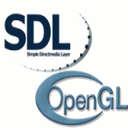Tutorial OpenGL v2.0
Finalmente chegou! Após quase 1 ano depois de meu primeiro artigo sobre OpenGL, chegou a versão 2.0. Clique e fique mais Geek.
[ Hits: 20.262 ]
Por: Thiago Henrique Hüpner em 08/05/2015
"Imagine" seu programa
Diferentemente do que devem estar pensando, colocar uma imagem no OpenGL é mais complexo do que o próprio SDL. Mas não desanimem, não é impossível!
Salve essa imagem como "sdl.bmp":

#include <SDL/SDL.h>
#include <SDL/SDL_opengl.h>
#include <time.h>
#define LARGURA 400
#define ALTURA 400
#define TAMANHO_IMAGEM 128
GLuint carregarImagem(const char *nomeImg) {
SDL_Surface *img = SDL_LoadBMP(nomeImg);
GLuint textura;
if(img == NULL) {
printf("Erro ao carregar a imagem %s: %s
",nomeImg,SDL_GetError());
SDL_FreeSurface(img);
exit(-1);
}
glGenTextures(1, &textura);
glBindTexture(GL_TEXTURE_2D, textura);
glTexParameteri(GL_TEXTURE_2D, GL_TEXTURE_MIN_FILTER, GL_LINEAR);
glTexParameteri(GL_TEXTURE_2D, GL_TEXTURE_MAG_FILTER, GL_LINEAR);
glTexImage2D(GL_TEXTURE_2D, 0, 3, img->w, img->h, 0,
GL_RGR, GL_UNSIGNED_BYTE, img->pixels);
SDL_FreeSurface(img);
return textura;
}
void colocandoImagemNaTela(GLuint textura, int x,int y) {
glBindTexture(GL_TEXTURE_2D, textura);
glLoadIdentity();
glTranslatef(x,y,0);
glBegin(GL_QUADS);
glTexCoord2f(0, 0);
glVertex2f(0, 0);
glTexCoord2f(1, 0);
glVertex2f(TAMANHO_IMAGEM, 0);
glTexCoord2f(1, 1);
glVertex2f(TAMANHO_IMAGEM, TAMANHO_IMAGEM);
glTexCoord2f(0, 1);
glVertex2f(0, TAMANHO_IMAGEM);
glEnd();
}
void inicializaOpenGL() {
glClearColor(255,255,255,1);
glMatrixMode(GL_PROJECTION);
glLoadIdentity();
//Necessário para exibir a imagem
glEnable(GL_TEXTURE_2D);
gluOrtho2D(0,LARGURA,ALTURA,0);
glMatrixMode(GL_MODELVIEW);
glClear(GL_COLOR_BUFFER_BIT);
}
void GL_FillRect(SDL_Rect a,int r,int g,int b) {
glLoadIdentity();
glColor3ub(r,g,b);
glBegin(GL_QUADS);
glVertex2f(a.x,a.y);
glVertex2f(a.x+a.w,a.y);
glVertex2f(a.x+a.w,a.y+a.h);
glVertex2f(a.x,a.y+a.h);
glEnd();
}
int main(int argc,char *argv[]) {
if(SDL_Init(SDL_INIT_VIDEO) < 0) {
printf("Erro : %s
",SDL_GetError());
return -1;
}
srand((unsigned)time(NULL));
SDL_GL_SetAttribute( SDL_GL_RED_SIZE, 8 );
SDL_GL_SetAttribute( SDL_GL_GREEN_SIZE, 8 );
SDL_GL_SetAttribute( SDL_GL_BLUE_SIZE, 8 );
SDL_GL_SetAttribute( SDL_GL_ALPHA_SIZE, 8 );
SDL_GL_SetAttribute( SDL_GL_DOUBLEBUFFER, 2 );
SDL_Surface * tela = SDL_SetVideoMode(LARGURA,ALTURA,32,SDL_OPENGL);
if(tela == NULL) {
printf("Erro : %s
",SDL_GetError());
SDL_Quit();
return -1;
}
SDL_WM_SetCaption(""Imagenando"",NULL);
SDL_Event evento;
int estaRodando = 1;
inicializaOpenGL();
GLuint textura = carregarImagem("cb.bmp");
while(estaRodando) {
while(SDL_PollEvent(&evento)) {
switch(evento.type) {
case SDL_QUIT:
estaRodando = 0;
break;
default:
break;
}
}
glClear(GL_COLOR_BUFFER_BIT);
colocandoImagemNaTela(textura,50,50);
SDL_Delay(30);
SDL_GL_SwapBuffers();
}
SDL_Quit();
glDeleteTextures(1, &textura);
return 0;
}
Esse exemplo não possui comentários explicando, mas deixe que eu explico:
#define TAMANHO_IMAGEM 128 :: Eu utilizei essa constante pois ajuda na hora de desenhar na tela. Se quiser, deixe como está, mas se sua imagem não for de 128x128, ela poderá ser deformada.
GLuint carregarImagem(const char *nomeImg) :: É a função encarregada de converter uma imagem carregada pelo SDL em textura do OpenGL (e retorna um GLuint, ou seja, um "unsigned int 'padronizado'".
glGenTextures(1, &textura) :: O OpenGL gera um "objeto de textura" que será encarregado de armazenar uma textura.
glBindTexture(GL_TEXTURE_2D, textura) :: O OpenGL "diz" ao "objeto de textura" que será carregado uma "GL_TEXTURE_2D", ou seja, carregará uma imagem em 2D.
glTexParameteri(GL_TEXTURE_2D, GL_TEXTURE_MIN_FILTER, GL_LINEAR);
E:
glTexParameteri(GL_TEXTURE_2D, GL_TEXTURE_MAG_FILTER, GL_LINEAR); :: Definem as propriedades de "alongamento", ou seja, como será o preenchimento caso seja maior que a imagem. Por exemplo, a imagem é de 16x16 e será utilizado em um retângulo de 256x256 (por exemplo), com esses parametro irá definir como será a proporção.
glTexImage2D(GL_TEXTURE_2D, 0, 3, img->w, img->h, 0,
GL_RGR, GL_UNSIGNED_BYTE, img->pixels); :: Coloca a imagem do SDL na "textura" do OpenGL.
void colocandoImagemNaTela(GLuint textura, int x,int y) :: Essa função vai fazer o que o nome sugere: colocar a textura na tela.
glBindTexture(GL_TEXTURE_2D, textura); :: "Diz" ao próximos manipuladores que a textura a ser utilizada é a o conteudo da variavel "textura".
glTranslatef(x,y,0); :: Coloca a textura na posição X e Y
glTexCoord2f(0, 0); :: Aqui é a mesma regra do SDL_Rect, ou seja, o canto superior esquerdo = {0,0}, canto inferior esquero = {1,0},...
Main
GLuint textura = carregarImagem("sdl.bmp"); :: Carrega a textura da imagem "sdl.bmp".colocandoImagemNaTela(textura,50,50); :: Coloca a textura na posição X: 50 e Y: 50.
Bom, parece complicado. E é, mas após pegar o jeito isso daqui é moleza.
Com esse exemplo, se apenas modificarmos no Main, o "sdl.bmp" para outro nome de arquivo ou criar outra textura e colocar em outra posição também vai funcionar.
Temos um programa funcional. =D
2. Inicializando o SDL
3. OpenGL e SDL botando pra quebrar
4. Simulando uma Gambiarra
5. A jornada é longa parte 1 - Colisão Mouse e Retângulo
6. A jornada é longa parte 2 - Colisão entre 2 Retângulos
7. "Imagine" seu programa
8. Agradecimentos, links úteis e fontes
Ubuntu/Debian/Kali Linux e outros no Android
Túnel do Tempo: a função itoa()
Utilizando a biblioteca NCURSES - Parte II
Utilizando a biblioteca NCURSES - Parte I
Muito bom! Vou tentar criar um game simples pra minha filha ficar clicando no retângulo com a cor certa com base neste tutorial.
[1] Comentário enviado por fabio em 08/05/2015 - 10:30h
Muito bom! Vou tentar criar um game simples pra minha filha ficar clicando no retângulo com a cor certa com base neste tutorial.
Fábio, mais uma vez, muito obrigado !
E boa sorte com o aplicativo, espero que sua filha goste.
Qualquer dúvida só pedir =D
[]'s
T+
Bom artigo!
Favoritado e pega meu 10!
Até
[3] Comentário enviado por UmCaraAToa em 08/05/2015 - 11:25h
Bom artigo!
Favoritado e pega meu 10!
Até
Valeu fera
T+
Favoritado. Vou ler depois com calma. Mas só de dar uma olhada por rápida vi que é material interessante!
--
http://pastebin.com/aji5Qp05
[5] Comentário enviado por xerxeslins em 08/05/2015 - 11:49h
Favoritado. Vou ler depois com calma. Mas só de dar uma olhada por rápida vi que é material interessante!
--
http://pastebin.com/aji5Qp05
Valeu fera, Obrigado!
[]'s
T+
Parabéns pelo artigo escrito, é uns dos melhores (e únicos) artigos sobre OpenGL aqui no VOL.
[7] Comentário enviado por preroeb em 08/05/2015 - 19:02h
Parabéns pelo artigo escrito, é uns dos melhores (e únicos) artigos sobre OpenGL aqui no VOL.
Valew pela força!
Dando duro pra trazer um artigo de qualidade pra vocês, meu povinho do "Volzinho"!
[]'s
T+
Ae Parabéns brother excelente artigo , favoritado aqui tbm :)
Igor Felipe
Cadastrado desde: 25/09/2009
[b]If it moves , compile it.[/b]
[9] Comentário enviado por Felipeigor em 08/05/2015 - 19:43h
Ae Parabéns brother excelente artigo , favoritado aqui tbm :)
Igor Felipe
Cadastrado desde: 25/09/2009
[b]If it moves , compile it.[/b]
Valew Tambem pelo apoio!
[]'s
T+
Legal cara, bem explicada a parte sobre colisão. Um bom artigo como um todo. Parabéns.
[11] Comentário enviado por SamL em 09/05/2015 - 12:50h
Legal cara, bem explicada a parte sobre colisão. Um bom artigo como um todo. Parabéns.
Valew Sam! Sempre me apoiando!
[]'s
T+
Oi, Thiago!
Dei uma rápida lida no seu artigo.
Está muito bom!
Continue assim, com essas ótimas contribuições!
Ang,
Manaus, AM, Brasil.
Usuário de sistemas operacionais livres/abertos tipo Unix ou tipo DOS,
Distros Favoritas: FreeBSD, Free-DOS, , PC-DOS, Bodhi Linux, Ubuntu, Big Linux, Kurumim, OpenSUSE, Slackware e Slax.
[13] Comentário enviado por Ang em 09/05/2015 - 16:14h
Oi, Thiago!
Dei uma rápida lida no seu artigo.
Está muito bom!
Continue assim, com essas ótimas contribuições!
Ang,
Manaus, AM, Brasil.
Usuário de sistemas operacionais livres/abertos tipo Unix ou tipo DOS,
Distros Favoritas: FreeBSD, Free-DOS, , PC-DOS, Bodhi Linux, Ubuntu, Big Linux, Kurumim, OpenSUSE, Slackware e Slax.
Valew !
Obrigado por ter lido!
[]'s
T+
Patrocínio
Destaques
Artigos
Como atualizar sua versão estável do Debian
Cirurgia para acelerar o openSUSE em HD externo via USB
Void Server como Domain Control
Dicas
Script de montagem de chroot automatica
Atualizar Linux Mint 22.2 para 22.3 beta
Jogar games da Battle.net no Linux com Faugus Launcher
Como fazer a Instalação de aplicativos para acesso remoto ao Linux
Tópicos
De volta para o futuro - ou melhor, para o presente (parte 2) (2)
Por que passar nas disciplinas da faculdade é ruim e ser reprovado é b... (7)
Top 10 do mês
-

Xerxes
1° lugar - 148.282 pts -

Fábio Berbert de Paula
2° lugar - 66.968 pts -

Buckminster
3° lugar - 22.355 pts -

Mauricio Ferrari
4° lugar - 20.972 pts -

Alberto Federman Neto.
5° lugar - 20.027 pts -

edps
6° lugar - 18.910 pts -

Daniel Lara Souza
7° lugar - 17.962 pts -

Andre (pinduvoz)
8° lugar - 16.323 pts -

Alessandro de Oliveira Faria (A.K.A. CABELO)
9° lugar - 15.699 pts -

Jesuilton Montalvão
10° lugar - 14.946 pts




